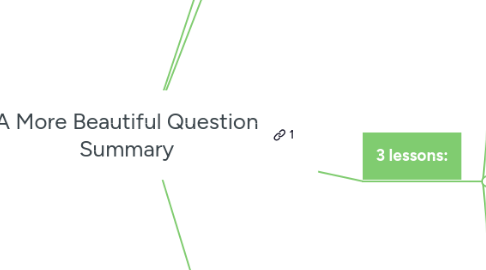
1. 1-Sentence-Summary:
1.1. A More Beautiful Question will teach you how to ask more and better questions, showing you the power that the right questions have to transform your life for the better.
2. Favorite quote from the author:
2.1. "You don't learn unless you question." - Warren Berger
3. 3 lessons:
3.1. We are born with the important and useful trait of curiosity, but we lose most of this skill when we go to school.
3.1.1. Questions set humans apart from other species on earth.
3.1.2. And not only that, but they are vital to our survival and success.
3.1.2.1. When we investigate the world around us we learn to be creative and come up with new ideas that improve our lives.
3.1.3. It’s important to know what you don’t know, but until you ask, you’ll never figure that out so you can learn more.
3.1.4. Children ask a lot of questions. One estimate put the number at 40,000 questions a day from kids between two and four!
3.1.4.1. The research indicates that children don’t just seek attention either. They genuinely want to know about the world around them.
3.1.5. Sadly, the American education system smothers this valuable skill.
3.1.5.1. To be successful in school, you have to become good at learning facts so you can do well on tests.
3.1.5.2. There’s no room to nourish curiosity when you’re worried about useless facts like what year the war of 1812 was.
3.2. Ask “why?” to get smarter, but learn to ask “why not?” to become a more innovative thinker.
3.2.1. “Why?” is known as a naive question because of the innocent, child-like wonder that it represents.
3.2.1.1. It’s good to wonder why things are a certain way because it helps us take apart and understand complex issues.
3.2.2. “Why?” questions have their limits though. To go from simply getting answers to finding solutions to problems, we must ask “why not?”
3.2.2.1. The power in this second beautiful question is in its ability to make us question our basic assumptions about the world.
3.2.3. Many people just do what they do because “this is the way it’s always been done,” without ever questioning it.
3.2.3.1. When you ask “why not?” you unleash the power of an innovative mind. This kind of thinking has changed lives, and our entire world.
3.3. If you want to be more creative, try “what if?” questions, and for help taking action use “how?” questions.
3.3.1. Imagine you lived in a village near a river. To get to the other side, people had to walk the bank until a shallow spot provided a way to cross.
3.3.1.1. If you ask “why?” that might not get you anywhere.
3.3.1.2. But asking “what if we built a bridge?” get you thinking outside of the box and on the road to solutions.
3.3.1.3. While exciting, this question is only part of what you need to solve your problem. To get the bridge built, you have to ask “how?”
3.3.2. "How?" is the most difficult to answer.
3.3.2.1. It requires commitment, patience, and endurance to ask “how?”
3.3.2.2. You have to be determined to follow-through with exploring all the necessary steps to solve your problems. But knowing how to implement your solutions is vital to seeing them become reality.
3.3.3. By combining this question with the others, you give yourself the ability to put your new, life-changing ideas into action.
